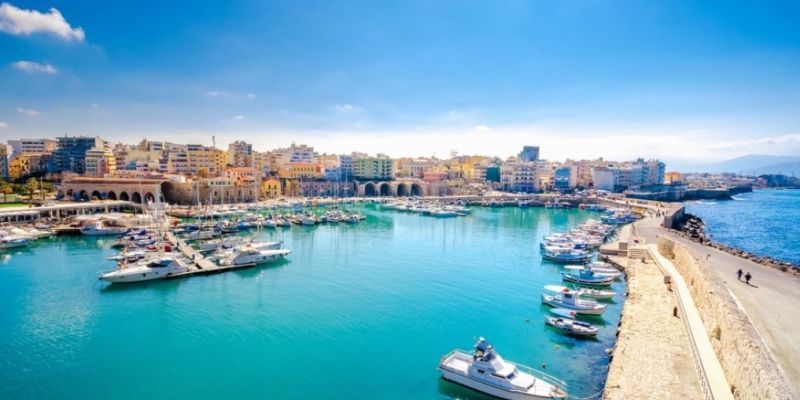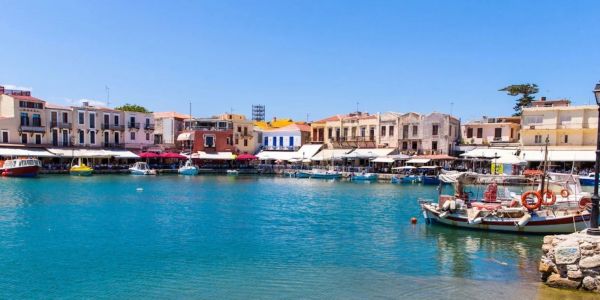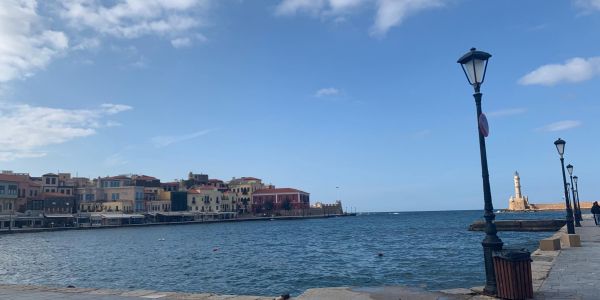Heraklion (Iraklio), Crete's largest city, is situated at the north and center of the island (144km east of Chania and 128km west of Sitia). Heraklion International airport Nikos Kazantzakis is just 5km away from the city center and Heraklion port connects the city with Santorini, Piraeus, Cyclades, Dodecanese and Rafina.
Its geographical position helped the city thrive as an administrative and economical centre till this day. It's population is according to 2011 cencus 140.730 citizens and still growing. During summertime the population of the city may rise to 200.000 people.
Heraklion is a city, buzzing and full of life all year around, providing all the necessary commodities and services for locals and visitors. The last couple of years ther's been a huge effort from the majority of local companies and the municipality to modernize their brands, so that they are able to provide experiences, products and services in high standards and in a friendly way, in other words there has been a positive 'facelift' to almost every aspect of life in Heraklion.
The city still tries to find its character, due to the 80's booming development which lead to a weird mixture of Venetian structures and modernlike buildings, but in a way it makes these small and sometimes hidden picturesque corners, stand out even more and reward the visitor.
Brief history
Heraklion is a city build upon other cities. It's not clear yet, but archeologists have developed a theory that it's been populated since 3.000BC and operated as the port of Knossos Palace with a small settlement surrounding it. After the downfall of the Minoan civilization and its capital, Knossos, poor development was noticed all over Crete until the arrival of the Roman empire.
The Roman empire during the rime that ruled the island retained Gortys (Gortyna) as the island's capital , so little to none attention was paid to Heraklion. The foundations of today's Heraklion weren't built until 824AC when the Arabs took over the island from the Eastern Roman empire. They've also constructed a moat around the city for protection and the port was used for raids against ships of the Byzantine empire. At that time the city was called Castle of the Moat.
In 961AC after a long siege the island was under the rule of the Byzantine empire and the city was renamed Chandax (Handax).
Along with the arrival of Venetians (1204AC, the city was sold to the Republic of Venice) astonishing development in constructions, economy, arts and renovations was noticed. The city was fortified against pirates (Koules fortress) and flourished until 1645.
After a very long seige that lasted 24 years, the city was under the rule of the Ottoman empire. It remained the island's capital city until 1849. In 1898 the autonomous Cretan State was created, and the city was renamed Heraklion from the Roman Heracleum.
In 1913 Heraklion and the Cretan State were united with the rest of Greece. In 1971, Heraklion was again the administrative capital of Crete which led to more economical development.
Things to do
As said above, Heraklion is a vivid city all year around, not just during the summertime but along winter and autumn as well. The city has a large variety of cafes, bars, restaurants, taverns, city hotels and apartments, a great market with most of the big firms, open markets where you can buy local biological products, museums and events like music concerts, open air cinema viewings, dance exhibitions and lately many athletic tournaments.
Some of Heraklion's biggest attractions are:
- - The Archeological museum of Heraklion
- - The Natural History museum of Crete
- - Koules fortress and the Venetian walls
- - The downtown market
- - St Minas Cathedral
- - St Titus Cathedral
- - 25th August street
- - Loggia the city hall
- - Kazantzakis' grave
- - Morozini's fountain
- - The open air cinema within the city walls
and many other hidden gems scattered across the city.
Heraklion is also a very accommodating base to explore nearby places of interest such as:
Museums & archeological sites
- - Knossos Palace - 6km south, 15min driving
- - Nikos Kazantzakis museum in Myrtia village - 16km, 25min driving
- - El Greco museum at Fodele - 33km west, 35min driving
- - The archeological site of Malia - 41km east, 40min driving
- - The archeological site of Gortys - 54km south, 55min driving
- - Faistos - 52km south, 1hr & 10min driving
Beaches
- - Agia Pelagia – 27km west , 35min driving
- - Matala - 63km southwest, 1hr driving
- - Agia Galini - 72km southwest, 1hr 20min driving
- - Kolokytha beach – 73km east, 1hr 20min driving
- - Lentas and Diskos beach - 67km south, 1hr 20min driving
Places of interest
- - Archanes village - 15km south, 25min driving
- - The wineries at Peza - 20km, 30min driving
- - Rouvas forest and Zaros lake - 47km southwest, 55min driving
- - Agios Nikolaos city - 62km east, 1hr driving
- - Elounda, Plaka and Spinalonga - 70km east, 1hr 10min driving
- - Lassithi plateau and Psychro cave - 60km southeast, 1hr 20min driving
- - Rethimno city - 82km west, 1hr 20min driving
- - Arkadi monastery - 82km southwest, 1hr 20min driving
(Distances and driving time are calculated from the city center so they may vary depending on traffic)
And what's the easiest way to visit these places? By hiring a car from SunRise Car Rentals of course!
Other useful info:
Municipality of Heraklion website
Heraklion Port website
Heraklion Airport website
Archeological museum of Heraklion link
Archeological site of Knossos link



